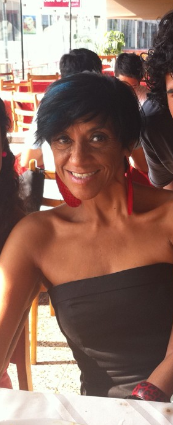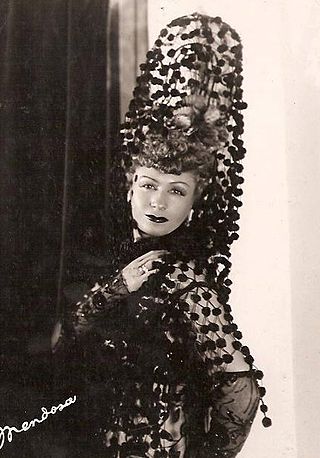
Laura Ana "Tita" Merello was an Argentine film actress, tango dancer and singer of the Golden Age of Argentine Cinema (1940–1960). In her six decades in Argentine entertainment, at the time of her death, she had filmed over thirty movies, premiered twenty plays, had nine television appearances, completed three radio series and had had countless appearances in print media. She was one of the singers who emerged in the 1920s along with Azucena Maizani, Libertad Lamarque, Ada Falcón, and Rosita Quiroga, who created the female voices of tango. She was primarily remembered for the songs "Se dice de mí" and "La milonga y yo".

Concepción Velasco Varona, known professionally as Concha Velasco, also Conchita Velasco, was a Spanish actress, singer, dancer, television presenter, and theatrical producer. She received numerous accolades throughout her career in film, theater, and television spanning over six decades, including two National Theater Awards presented by the Spanish Ministry of Culture in 1972 and 2016, the Lifetime Achievement Award presented by the Spanish Television Academy in 2009, and the Honorary Goya Award presented by the Spanish Film Academy in 2012.

Natalia Millán is a Spanish actress, dancer and singer.
A vedette is the main female artist of a show derived from cabaret and its subcategories of revue, vaudeville, music hall or burlesque. The purpose of the vedette is to entertain and captivate the public. Vedettes are expected to sing, dance and act on stage. Particularly accomplished artistes are considered super vedettes or first vedettes. Vedettes often appear alongside groups of dancers, flashy and revealing costumes, magicians, comedians, jugglers, or even performing animals. Vedettes specializing in burlesque generally do striptease and may also perform nude on stage.

Carmen Lamas was a Spanish-born tango singer, and the first Spanish actress who made her career in Argentina. Lamas debuted in 1921 in a cast headed by his father, Miguel Lamas, Spanish actor and director. She was one of the first important figures of the Teatro Maipo, a vedette in the group known at that time as "Primera triple".

María de los Ángeles López SegoviaOAXS MML, better known as Lina Morgan, was a Spanish film, theater, radio, revue and television actress and vedette. Throughout her career, she stood out for playing mostly comic roles and those related to popular genres such as the Spanish revue and musical comedy. She was also the theater impresario and owner of the Teatro La Latina in Madrid.

Nathalie Poza Maupain is a Spanish film, stage, and television actress. She is the recipient of several accolades including two Goya Awards, one Platino Award, and five Actors and Actresses Union Awards.
María Begoña Labraga Picado, better known by the stage name of Mary Begoña, was a Spanish vedette and actress. She started dancing at age 7 and performed in venues in Madrid while she was studying at the Academies of Quiroga, Ompín and Monreal. Then she studied with Antonio Bautista and Sacha Goudine in Barcelona. She debuted in a musical revue at the age of fourteen and during Spanish Civil War was part of the CNT Union. In 1943, Begoña worked in Valencia in Juanita Reina's acting troupe, but returned to Madrid to debut in the Teatro Calderón. In 1945 she appeared in the revue Danubio Azul with Manolo Caracol and Lola Flores and the following year was the principal vedette in the revue De la Tierra a Venus. For the next several years she performed in variety shows with various acting troupes, such as Tres días para quererte (1945), ¡Róbame esta noche! (1947), A La Habana me voy (1948). In 1951, she did a season in the US and then returned to Spain appearing in ¡A vivir del cuento! (1952) and Los líos de Elías (1954). Begoña then formed her own company, which between 1953 and 1960 performed ten different plays. As her career declined in revue style shows, she began performing in comedy theater, film, and television.

This is a chronological list of live performances by Alfredo Rossi from 1919 to 1983. The list is incomplete because no concerts without references are listed.
Thelma Delia Suklenik Snopik, better known by her stage name Thelma Tixou, was a Mexican vedette and actress of Argentine origin. She was one of the most popular Mexican vedettes during the 1970s and 1980s, and she became famous worldwide for her role as The Tattooed Woman in Alejandro Jodorowsky's cult classic film Santa Sangre (1989).

Rosa Bertha Oneto Martínez, better known as Bettina Oneto, is a Peruvian actress, humorist, singer, stand-up comedian, and producer.
Raquel Daina Delas was a Spanish comedy actress and zarzuela performer during the first and second half of the 20th century in Spain and America. She was also a theatrical entrepreneur, vedette, actress and model.

Carmen Olmedo (1909-1985) was a Peruvian actress, dancer, songwriter and vedette who made a career in Argentina, Chile and Spain.

Victoria Cuenca was an Argentine film actress during Argentina's Golden Age of cinema, as well as a theatre actress and a vedette.
This is a list of Spanish television related events from 1959.
This is a list of Spanish television related events in 1974.
This is a list of Spanish television related events in 1976.

Rosita Rodrigo was a Spanish actress, vedette, dancer and songwriter, highly successful in Spain, Mexico, Cuba, and Argentina. Among her most popular songs are the Valencian zarzuela, "Les barraques" and "Muñequita de trapo." She was also linked to politics, such as her relationship with Alfonso XIII.

Hortensia Arnaud was a pioneering Argentine dancer, vedette, and actress of film and stage. Arnaud made significant incursions during the heyday of cinematography and revue theater. Above all, she was a pioneer bataclana and premier dancer in Buenos Aires during the 1920s and 1930s.

Teresa Juliana Lucía Maraval Torres was a Spanish tonadillera, cupletista, and actress who also made a career in Argentina. In Spain, she performed in the Teatre Principal, Teatro Romea, and Teatro Maravillas. In Argentina, she was a performer at the Odeon Theater, Teatro Splendid, Teatro Marconi, Teatro Avenida, Teatro Comedia, Teatro Empire, Teatro Nuevo, Teatro Nacional, and Teatro Florida/Galería Güemes. Her film debut occurred in 1929, in La del Soto del Parral.













